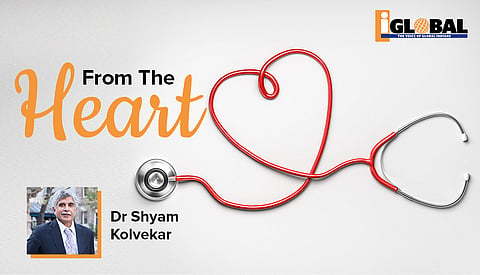

Research indicates that the UK accounts for around 60,000 cases of suspected cardiac arrest every year that mostly occurs at home or in a workplace witnessed by a bystander. However, only one in 10 manage to survive an out-of-hospital cardiac arrest.
Leading Cardiothoracic Surgeon Dr Shyam Kolvekar with over 35 years of experience wants the iGlobal audience to be able to perform basic CPR because “one day anyone of us could be at the receiving end”.
Let’s hear it from the expert about the golden five minutes:
CPR stands for cardiopulmonary resuscitation. It combines chest compressions and rescue breaths to give a person the best chance of survival when given within the first five minutes following a cardiac arrest.
To recognise a cardiac arrest, Dr Kolvekar suggests looking for signs of slow, laboured breathing, an unresponsive person with absent or abnormal breathing or short periods of seizure-like movements at the start of the arrest.
While waiting for the emergency help or an ambulance to arrive, the medic says that you can deliver chest compressions on the lower half of the sternum (in the centre of the chest). Start by compressing the chest either to the beats of Bee Gee’s Stayin Alive or in other words at a rate of 100-200 per minute with as few interruptions as possible up to a depth of at least 5cm but not more than 6cm.
He further explains that it is important to allow the chest to recoil completely after each compress and to avoid leaning on the chest. “Rescue breaths are risky in time of coronavirus therefore I advise giving continuous chest compressions.”
MORE LIKE THIS…
Dr Kolvekar remarks, “as soon as the AED (Automated External Defibrillator) arrives, turn it on immediately and follow the verbal prompts.” A defibrillator is usually located in workplaces and public areas like airports, shopping malls and train stations.
You don’t need to be a trained professional to be able to use one. You simply must attach the appropriate pads to the patient’s skin in the indicated locations and pause the CPR to allow the AED to analyse the rhythm.
“If the rhythm is not shockable, initiate 5 cycles of CPR again and recheck at the end.”
“If the shock is indicated on the defibrillator, then assure no one is touching the patient and press the shock button before resuming another 5 cycles of CPR.”
Certain adults and children with a decreased level of responsiveness due to a medical illness or a non-physical trauma might not meet the criteria for the initiation of rescue breathing or chest compressions. In this case, Dr Kolvekar recommends that “they be placed into a lateral, side-lying recovery position.”
Here are the steps to be followed:
Kneel beside the person and make sure that both legs are straight.
Place the arm nearest to you out at a right angle to the body with the palm facing upwards.
Hold the back of the far arm across the person’s cheek.
Grasp the far leg just above the knee and pull it up keeping the foot on the ground.
Keeping the hand pressed against the cheek, pull the far leg to roll the person towards you.
Adjust the upper leg so that both the hip and knee are bent at right angles.
Tilt the head back to make sure the airway remains open and downwards to allow liquid material to drain from the mouth.
Check regularly for normal breathing
MORE LIKE THIS…
When you suspect that someone is choking particularly while eating, firstly encourage the person to cough. “If the cough becomes ineffective, give up to 5 back blows between the shoulder blades using the heel of your hand.”
He adds: “If the choking still continues, give 5 abdominal thrusts between the navel and the ribcage using your fist. In case the person is still not responding, dial 999 and start CPR.”
Dr Shyam Kolvekar is a Consultant Cardiothoracic Surgeon at St. Bartholomew’s Hospital in the City of London. He practices at the Royal Free Hospital, Harley Street Clinic, Wellington Hospital and London Clinic. He specialises in mitral valve repairs, beating-heart surgery, cardiac arrhythmias, correcting chest wall deformities, pneumothorax and lung cancer. He is an internationally recognised surgeon for adolescent and adult NUSS procedures.
*More Info: British Heart Foundation; St John Ambulance